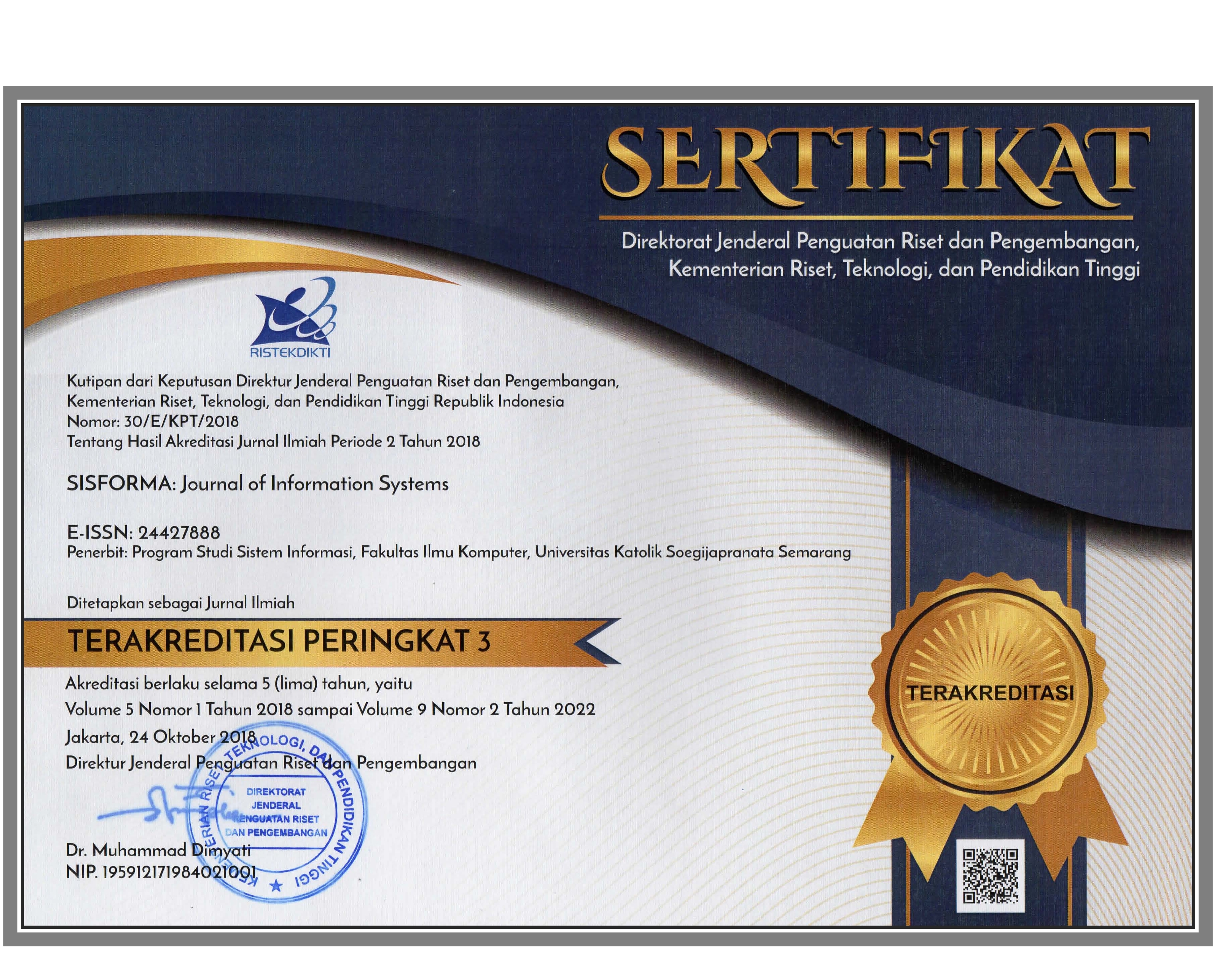Development of Management Information System Reservations Using Simple Multi-Attribute Rating Technique (SMART) Based on Android Mobile Applications
Abstract
Keywords
Full Text:
PDFReferences
A. Habib, M. A. Jani, D. A. Pratama, and E. Ronando, “Development of archives management information system with RFID and SMS gateway,” International Journal of Psychosocial Rehabilitation, vol. 24, no. 4, pp. 5227–5243, 2020, DOI: 10.37200/IJPR/V24I4/PR201621.
R. A. Santana, D. Risqiwati, and Z. Sari, “Rancang Bangun Sistem Informasi Servis Oli Sepeda Motor Menggunakan Odometer Berbasis LBS,” Kinetik, vol. 2, no. 1, p. 17, 2017, doi: 10.22219/kinetik.v2i1.98.
I. L. Andrey Kartika Widhy Hapantenda, Ardy Januantoro, “STUDI INDEPENDEN KOMPARASI SEGMENTASI SEL DARAH PUTIH MENGGUNAKAN RUANG WARNA HSV DENGAN CIE-L*a*b,” Konvergensi, vol. 15, 2019.
A. Habib and B. Al Kindhi, “Rancang Bangun Sistem Informasi Manajemen Keuangan Sekolah,” INTENSIF: Jurnal Ilmiah Penelitian dan Penerapan Teknologi Sistem Informasi, vol. 2, no. 2, p. 136, 2018, doi: 10.29407/intensif.v2i2.12139.
Yudhi and A. Rustam, “Perancangan Aplikasi Mobile Untuk Pemasaran Produk Dan Jasa Ke Berbagai Situs E-Commerce Di Indonesia,” Jurnal Informasi Volume VI No. 2/November/2014, vol. VI, no. 2, pp. 88–99, 2017.
M. Siregar et al., “Rancang Bangun Aplikasi Berbasis Mobile Untuk Navigasi Ke Alamat Pelanggan Tv Berbayar (Studi Kasus: Indovision Cabang Pekanbaru) 1,” Jurnal Rekayasa dan Manajemen Sistem Informasi, vol. 2, no. 1, pp. 82–94, 2016, [Online]. Available: www.hostinger.co.id.
A. Purwanto and A. Nugroho, “Analisis Rancangan Teknologi Mobile Application Pada E-Booking Ruangan Untuk Kegiatan Ukm,” Jurnal Teknologi Informasi dan Komputer, vol. 4, no. 1, pp. 66–70, 2018, doi: 10.36002/jutik.v4i1.396.
A. Habib and A. D. Wibowo, “Aplikasi Pengingat Agenda Berdasarkan Lokasi Dengan Global Positioning System (Gps) Berbasis Android,” Konvergensi, vol. 11, no. 02, 2016, doi: 10.30996/konv.v12i01.862.
S. Syaifuddin, Z. Sari, and M. K. Masduqi, “Analysis of Uapush Malware Infection using Static and Behavior Method on Android,” Kinetik, vol. 3, no. 1, p. 83, 2018, doi: 10.22219/kinetik.v3i1.265.
C. Kirana and R. Wahdaniyah, “Implementasi Aplikasi Alumni Berbasis Mobile Application,” Jurnal Edukasi dan Penelitian Informatika (JEPIN), vol. 4, no. 2, p. 179, 2018, doi: 10.26418/jp.v4i2.25752.
D. Defrina and D. P. Lestari, “Aplikasi Pemesanan Makanan Dan Minuman Online Aplication of Ordering Food and Beverages Online Based on Mobile Browser on Tiga Saudara Restaurant,” Jurnal Ilmiah Informatika dan Komputer, vol. 22, no. 3, pp. 158–170, 2017, [Online]. Available: http://ejournal.gunadarma.ac.id/index.php/infokom/article/view/1736.
L. Candra and A. A. Alkodri, “Aplikasi Pemesanan Makanan Pada Bangka Original Cafe Berbasis Client Server Dengan Platform Android,” Jurnal Sisfokom (Sistem Informasi dan Komputer), vol. 3, no. 2, p. 34, 2014, doi: 10.32736/sisfokom.v3i2.205.
I. Inayati, “Aplikasi Pemesanan Makanan Berbasis Web,” e-NARODROID, vol. 1, no. 2, 2015, doi: 10.31090/narodroid.v1i2.71.
A. Izzah, “Prediksi Harga Saham Menggunakan Improved Multiple Linear Regression untuk Pencegahan Data Outlier,” Kinetik, vol. 2, no. 3, pp. 141–149, 2017, doi: 10.22219/kinetik.v2i3.268.
A. Suryadi, “Sistem Pendukung Keputusan Seleksi Ujian Masuk Perguruan Tinggi Menggunakan Nbc (Naïve Bayes Classifier),” Kinetik, vol. 1, no. 3, p. 173, 2016, doi: 10.22219/kinetik.v1i3.120.
Nurhasanah, “Pendukung Keputusan Penentuan Penerima Beasiswa Menggunakan Metode Smart ( Simple Multi Attribute Rating Technique ),” Majalah Ilmiah INTI, vol. XII, no. 1, pp. 60–66, 2017.
Y. E. Windarto, I. P. Windasari, and M. A. M. Arrozi, “Implementasi Simple Multi Attribute Rating Technique Untuk Penentuan Tempat Pembuangan Akhir,” Jurnal Pengembangan Rekayasa dan Teknologi, vol. 15, no. 1, p. 12, 2019, doi: 10.26623/jprt.v15i1.1484.
E. Oktavianti, N. Komala, and F. Nugrahani, “Simple multi attribute rating technique (SMART) method on employee promotions,” Journal of Physics: Conference Series, vol. 1193, no. 1, 2019, doi: 10.1088/1742-6596/1193/1/012028.
M. Safrizal, “Sistem Pendukung Keputusan Pemilihan Karyawan Teladan dengan Metode SMART (Simple Multi Attribute Rating Technique),” Jurnal CoreIT, vol. 1, no. 2, pp. 25–29, 2015.
D. diana, “Sistem Pendukung Keputusan Menentukan Kelayakan Bisnis Menerapkan Simple Multi Attribute Rating Technique (Smart),” Jurnal Ilmiah Matrik, pp. 113–124, 2016, doi: 10.33557/jurnalmatrik.v18i2.403.
N. Sesnika, D. Andreswari, and R. Efendi, “Aplikasi Sistem Pendukung Keputusan Pemilihan Gedung Serba Guna Di Kota Bengkulu Dengan Menggunakan Metode Smart Berbasis Android,” Jurnal Rekursif, vol. 4, no. 1, pp. 30–44, 2016.
J.-D. Huang, M. H. Hu, and H.-M. Wee, “Evaluation of Lead Logistics Provider Using the SMART Process: A Case Study in a Taiwan Automotive Industry,” Operations and Supply Chain Management: An International Journal, vol. 6, no. 1, pp. 26–35, 2014, doi: 10.31387/oscm0130084.
S. R. Cholil, A. P. R. Pinem, and V. Vydia, “Implementasi metode Simple Multi Attribute Rating Technique untuk penentuan prioritas rehabilitasi dan rekonstruksi pascabencana alam,” Register: Jurnal Ilmiah Teknologi Sistem Informasi, vol. 4, no. 1, p. 1, 2018, doi: 10.26594/register.v4i1.1133.
DOI: https://doi.org/10.24167/sisforma.v8i1.3024
Refbacks
SISFORMA: Journal of Information Systems | p-ISSN: 2355-8253 | e-ISSN: 2442-7888 | View My Stats

This work is licensed under a Creative Commons Attribution 4.0 International License.





















